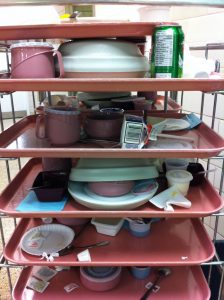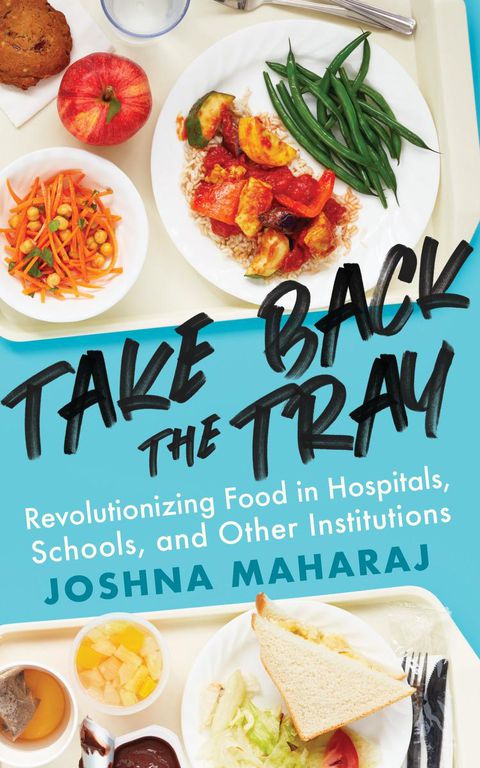I caught up with Joshna Maharaj, author of the newly-released Take Back the Tray: Revolutionizing Food in Hospitals, Schools, and Other Institutions. A self-proclaimed chef-activist, Maharaj lives in Toronto and spent years working as a chef in hospital and university settings, where she observed the ways that food in large-scale institutions fails in nutrition and sustainability. Her book is part memoir, part rallying call for change.

Chef-activist Joshna Maharaj
Sustain: What is the focus of Take Back the Tray?
Maharaj: The book chronicles a lot of my work, with a real focus on the work I’ve done in public institutions to overhaul the menu, but it feels really important to say that throughout the entire time, all I was really trying to do was bring some sustainability into those practices. One of the big verdicts of my investigation into institutional food is that it is a bastion of really unsustainable food production. The way things are rolling cannot continue.
Some people are more or less ready to hear that, so I repackaged it as transparency and accountability. The book, I hope, can be both a compelling narrative about what my experience has been, but I really wanted to inspire people on the ground to think about their relationship to food and what that culture and community looks like around us. The two guiding principles are hospitality and sustainability. What I’m arguing is that for any food operation, you need to be anchored by hospitality and sustainability.
“Hospitals have this reputation for frugality, and trimming the fat, but the model they have chosen is in fact much more wasteful than anything they were pushing back on that I was suggesting.”
Sustain: What are the big issues?
Maharaj: The whole system is wasteful. This system has all this processed food coming in — who knows how much what level of waste happened at that remote facility — then it is vac-sealed and wrapped in cardboard, put on a rack, wrapped in plastic wrap. Then it gets wrapped up in more disposability because no one’s investing in real china, then it gets rolled up to patients, but on average, about 30% of what is on those trays gets returned to the kitchen. The final nail in the coffin is that because of infection controls in a hospital, all that food goes right to a landfill. Whole pieces of fruit, whole cans of drinks…we couldn’t touch any of it. I thought, “How much money is just going in the garbage can?” Which means this account-driven style of foodservice is not actually working. Hospitals have this reputation for frugality and trimming the fat, but the model they have chosen is in fact much more wasteful than anything they were pushing back on that I was suggesting.

Hospital food has a reputation for being bad — and for good reason
Sustain: What are the barriers to creating a better system of institutional food?
Maharaj: I have found that ultimately, there is really no good reason for why institutional food is so bad. The only reason I’ve been able to settle on is that no one with any power cares enough to do anything differently. To me, that is not a good enough reason for the level of indignity and disrespect and waste that that system accompanies. While it’s comfortable to imagine that the first barrier is money — money is a barrier, no question — another piece is just people’s lack of desire to do a different thing. What I’m asking for is much bigger than new recipes and sourcing. The big barrier is that the attitude and culture around this service. That’s what thinks that these meals are okay to serve. That is what I want to tackle.
Sustain: How do you begin to introduce the concept of sustainability to these large-scale institutions?
Maharaj: You’ve got to find a way to take one bite. One of the ways I started was to attempt to unwind purchasing and how the money was spent. I had all these dreamy ideas: local, sustainable, organic. The real barrier was, how is the hospital going to pay for this? Not “where are we going to find the money” — logically, how are they going to get this cheque to a farmer? Everything comes with purchasing contracts and all this kind of nonsense. Farmers can’t wait 90 days for money. I finally figured it out and I was able to get accounts payable to do a shorter cheque run so that a farmer could in fact get a cheque. The purchasing thing was something I latched onto because I realized if we couldn’t figure it out, this thing was dead in the water.
Sustain: So it’s possible.
Maharaj: Yes, it’s very possible! They managed to get me a 15-day turnaround on an invoice. They did it. We did it. And the farmers were delighted. I think what we need to realize is that when you make these difficult changes and you rebuild the track, there are ripples of positive outcomes. That is the thing we need to pay more attention to. We are reinforcing the strength of our local communities.

Maharaj was able to create beautiful meals with farm-fresh ingredients, even in an institutional context
Sustain: Who do you hope will read this book?
Maharaj: As ambitious as this is to say, I will say that my target audience is everybody. Everybody has been in the hospital, or knows someone who’s been in the hospital, or has dropped their kids off at school, or knows someone in the prison system or who works in the prison system. I had written it imagining I was talking to someone who really cares and has a lot of questions about why things are the way they are. I wanted to put the power to make changes in the hands of the average person.
“Just by nature, being a profession that is as guided by hospitality as we are, [chefs] are really well suited to do this kind of work.”
Sustain: What can your colleagues in the food industry take away from the book?
Maharaj: There is a section on social gastronomy where I focus on talking to my colleagues in the industry about the opportunity that exists for us in the spaces outside of restaurants. Just by nature, being a profession that is as guided by hospitality as we are, we are really well suited to do this kind of work.
 Ultimately, the verdict I came to was that the thing that has been removed from institutional foodservice is hospitality. Administrators, and politicians, and whoever have decided that human connection is too expensive and not worth it anymore. That is something that I think will resonate with my fellow chefs, because it will not be the first time they’ve encountered that. This is chronic issue with our industry. However, by virtue of the fact that we have hospitality as a guiding principle makes us very suited to work in these spaces. We figure it out. We always work with crazy circumstances. We always figure it out. One of the most beautiful things is that taking those values around hospitality outside of a restaurant, into a community context — education, healthcare, rehabilitation, whatever it is — automatically maintains people’s dignity. Our communities need us.
Ultimately, the verdict I came to was that the thing that has been removed from institutional foodservice is hospitality. Administrators, and politicians, and whoever have decided that human connection is too expensive and not worth it anymore. That is something that I think will resonate with my fellow chefs, because it will not be the first time they’ve encountered that. This is chronic issue with our industry. However, by virtue of the fact that we have hospitality as a guiding principle makes us very suited to work in these spaces. We figure it out. We always work with crazy circumstances. We always figure it out. One of the most beautiful things is that taking those values around hospitality outside of a restaurant, into a community context — education, healthcare, rehabilitation, whatever it is — automatically maintains people’s dignity. Our communities need us.
Especially at this moment in time, when so many people are having to reinvent and rethink, and sadly let go of their restaurants, I really want to say that we are seeing a lot of opportunities open up for chefs to inhabit these different spaces in a way that is not soul-sucking. I’ve built a model that is about cooking food with farm-fresh ingredients, not vac-sealed flavourless nonsense. We could see the emergence of this whole other space of work for chefs that can be very meaningful and can allow them to do what they love in a different way.

